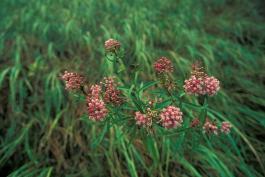
Swamp milkweed is a perennial herb. Stems smooth, tall, flexible, branching. Sap milky latex. Flowers mostly terminal (positioned at the tops of the stems), in many loose umbels (each rounded cluster arises from the same point); pink or rarely white, with a delicate fragrance. Blooms June–September. Leaves mostly opposite, narrowly lance-shaped, to 6 inches long and about 1 inch wide. Fruits slender pods, to 4 inches long, in pairs, smooth but usually slightly hairy, bearing seeds with silky parachutes.
Similar species: Swamp milkweed can be distinguished from similar milkweeds by its pink-flowered umbels (flower clusters) positioned at the tops of the plant stalks (not arising from the sides of the stems), relatively narrow leaves, and moist bottomland habitat.
Height: to 6½ feet.
Scattered nearly throughout the state.
Habitat and Conservation
Occurs in moist, open bottomlands, especially in the Missouri and Mississippi floodplains, where it is often the dominant plant. Look for it in swamps, sloughs, marshes, margins of ponds and lakes, banks of streams and rivers, bottomland prairies, and occasionally bottomland forests; also ditches and railroads.
Status
The entire former milkweed family (Asclepiadaceae) has recently been rolled into the dogbane family (Apocynaceae). For many years, botanists have known the two families were closely related. The milkweed group, with its distinct floral structures, is still considered a unique subfamily or tribe of the dogbane family. As you consult various sources, you can expect to see milkweeds grouped in either family.
Human Connections
Because they are a required larval food plant of monarchs, milkweeds are increasingly popular with native plant gardeners concerned about the decline of those butterflies, and swamp milkweed is a favorite for this. Young shoots and leaves of swamp milkweed, however, are browsed by rabbits and deer.
Ecosystem Connections
The roots are eaten by muskrats and other wetland mammals. Monarch butterflies use milkweeds as larval food plants, collecting the sap’s toxic cardiac gycosides in their bodies and becoming unpalatable to predators. Many insects visit the flowers for nectar.





















































